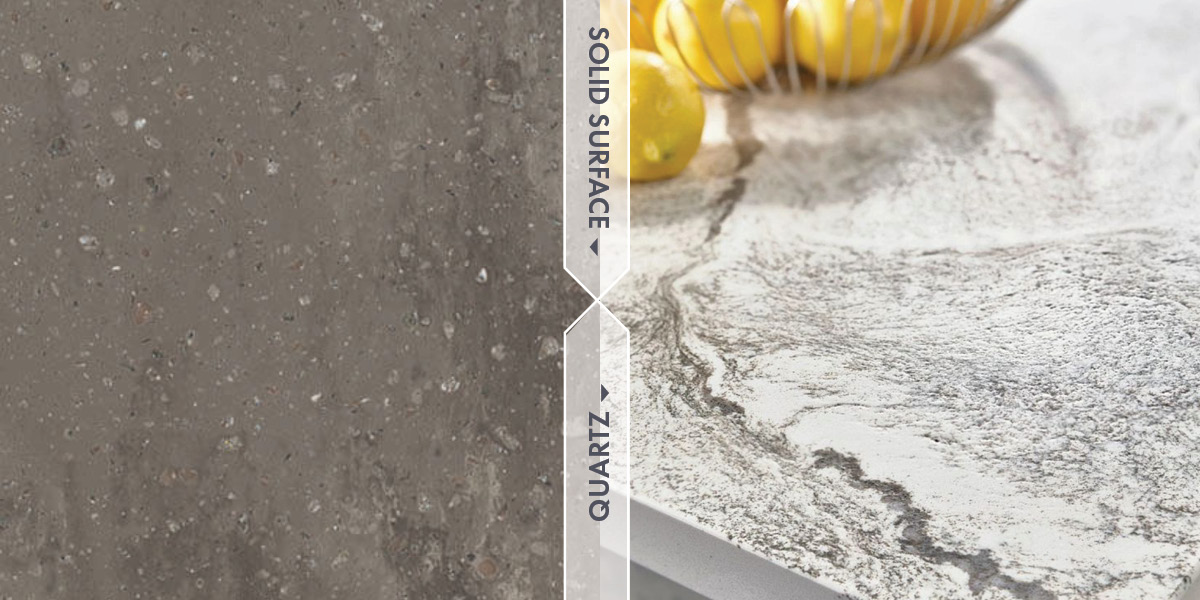
Some materials used in hotel casegoods and other guestroom furnishings seem to have a rivalry of sorts.
Granite vs. marble.
Plywood vs. particle board vs. softwoods.
The list goes on.
For our purposes in this article, we’ll look at two other materials that often go head-to-head in hospitality furniture casegoods: solid surface vs. quartz.
Both popular materials for hotel guest room furniture and in hotel reception furniture design, solid surface and quartz blend aesthetic with a unique level of functionality.
But as two distinctly different materials, each has its own place in creating custom hotel casegoods that meet their intended application and ROI.
What is Solid Surface?
A manufactured material, solid surface represents the combination of mineral dust, plastics, and resins. It often boasts a pebbled appearance.
A popular material in hospitality FF&E (fixture, furniture & equipment) manufacturing, solid surface is easily fabricated to most shapes and hotel furniture designs and comes in a variety of styles and appearances. Similar to laminates, solid surface can be made to look like other materials, such as natural stone.
In addition, solid surface is available for purchase to the exact specifications of a project – in other words, you won’t need to buy it in a giant sheet as you would with a material like marble or granite.
As a cost-effective material, solid surface helps stretch a hotel casegoods budget further. However, there are some considerations to keep in mind when adding solid surface to hotel casegoods.
Solid surface is prone to scratches and is not as strong as other materials. It’s also not heat resistant, meaning it will damage if exposed to high temperatures from, say a curling iron that hasn’t cooled down. What’s more, solid surface does stain more easily than other materials.
Still, solid surface does indeed have a place in hotel furniture design (we’ll get into that later).
What is Quartz?
Despite its name, quartz used in hotel casegoods is not a 100% natural material. Rather, it’s about 90% crushed quartz. The remaining 10% comprises either a cement-based or polymeric binder.
An engineered stone, quartz is (in many respects) the polar opposite of solid surface.
Because of its composition, quartz offers enhanced durability – meaning it can take a hit without showing signs of damage. Along the same line, quartz is a material that’s easily fabricated without losing integrity. With its durability, quartz is also scratch-resistant (an important quality when integrated into casegoods that see heavy use). In addition, quartz also withstands temperatures of up to 400℉. Unlike natural stone used in hotel casegoods, quartz does not require polishing and resealing as part of regular maintenance.
As a material that’s made to last, quartz is more expensive than solid surface. However, its ability to endure heavy use – or the occasional accidental hard hit – means an investment in quartz furniture is one in longevity.
Quartz Top vs Solid Surface: Applications
As with other material comparisons, when looking at quartz vs. solid surface, it’s not a matter of using one as opposed to the other. Rather, it’s determining which is best suited for the intended application.
Both solid surface and quartz are typically used for horizontal surfaces, such as countertops. The more robust of the two materials, quartz is used in part of casegoods that see more demanding use throughout their life, such as:
-
Luggage benches
-
Dressers
-
Vanities
-
Nightstand tops
-
Kitchenettes
Because of its unique, natural-looking aesthetic, quartz is also used as an accent to make casegoods stand out.
Solid surface requires a bit more forethought in how it’s used for hotel casegoods. As a less-durable material, solid surface is ideal for applications that see light use or have lower exposure to heavy impacts. Common solid surface furniture applications include:
-
Kitchenettes countertops
-
Casegood side panels
-
Reception desks
-
Vanities
-
Desks
Similar to low-pressure laminates, solid surface is a good fit for vertical applications, such as the back of a wardrobe or dresser.
Again, when choosing between both material types for a casegood, it’s important to consider the furnishing’s use and its expected lifespan. With an appropriate selection of either material, casegoods deliver on ROI.
Choosing the Right Material for Your Casegoods
As with any hotel casegoods project, getting the most for your money is a prime consideration. The last thing any hotelier or project manager wants is to spend thousands of dollars on custom furnishings only to replace them long before expected.
How do you make the best choice between solid surface vs. quartz for your casegoods?
Work with an experienced casegoods furniture manufacturer. As a seasoned professional that’s overseen many projects, they’re able to help you match a casegood’s intended use with expected years of service to get the best ROI.
Solid Surface Vs. Quartz Furniture
Despite their occasional rivalry, the decision between solid surface vs. quartz really isn’t one rooted in taking sides.
Rather, like other materials often considered against each other for hotel casegoods, choosing solid surface or quartz for your hospitality FF&E should be about choosing the right material for the application. Though both materials are different, they do share one common trait – each has a place in casegoods manufacturing.
Ready to Move Forward on a Casegoods Project?
Let our team have a look and send you a quote!

